
For a few months during spring, southern Indiana puts on quite the colorful show of wildflowers. Where is one of the best places to experience this display? Charlestown State Park in southern Indiana, about 30 minutes from Louisville.
With breathtaking scenic views of Fourteenmile Creek valley and the Ohio River, Charlestown has much to offer the visitor, including rugged hills and deep ravines. While hiking, you can see Devonian fossil outcrops and areas of karst sinkhole topography.
Early April to late May is prime time for many of Indiana’s native wildflowers. Blooming periods for each of these wildflowers vary, so you never know what you will find along the trails.
Here are some of the beauties you could see as you explore Charlestown State Park.

Purple Rocket, Lodanthus Pinnatifidus.
One of the more unusual members of the mustard family because it is native, non-weedy, has pale blue flowers and does not resemble any other species in the family. As the flowers age, their color fades to white.

Wild Columbine, Aquilegia canadensis
One of the most unique blooms, this species is the only native columbine to Eastern North America and is pollinated by hummingbirds. Traditionally, the gift of columbine, unlike most flowers, was not a gift of love. To a man, it was bad luck and to a woman, it was an insult! So, don't pick these (or any of the flowers) instead enjoy the view as you walk by!
Where to find them: These are most abundant along the bluffs on trail 6.
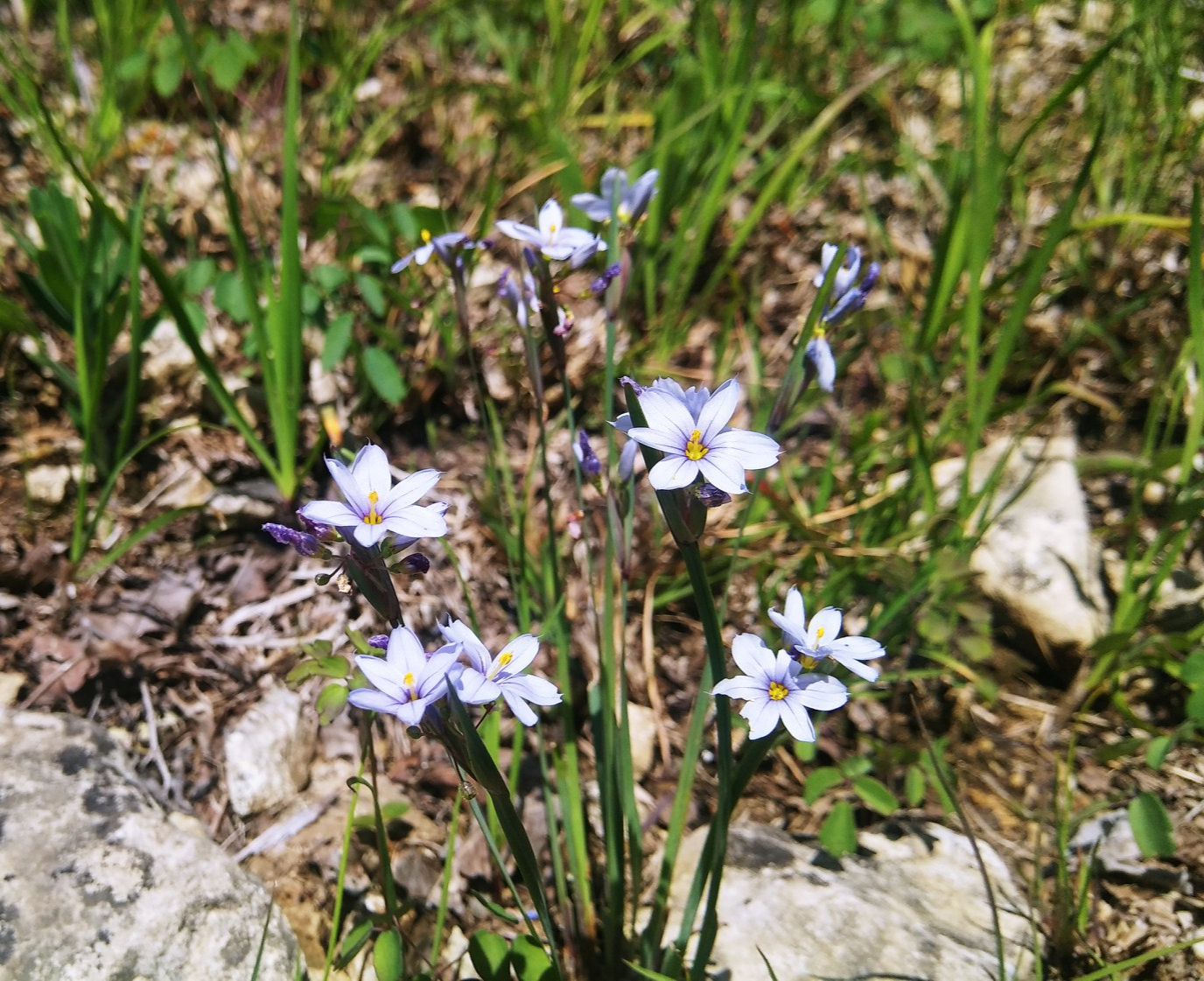
Blue Eyed Grass, Sisyrinchium Albidum
Though its name and appearance would lead you to believe it is a grass, this lovely wildflower is related to irises, not grass! Found in small clusters, the pale blue flowers appear to come right out of the 'blades of grass'.
Where to find: Not common on our trails, but has been seen along some, including the Rose Island trail!

Shooting Star, Dodecatheon Meadia
This wildflower is a rare sight in our woods! White flowers are most common, but occasionally there are some with a pink or lavender hue. The common name of this member of the primrose family refers to the flowers resemblance of a star shooting across the night sky! How appropriate of a name for such a rare sight!

White Baneberry, Actaea Pachypoda
This wildflower is common, but it is often overlooked. Reaching up to 30" tall, its tiny white flowers appear in spring in short, oblong terminal clusters atop long greenish stems that rise above the foliage. Flowering stems thicken after bloom and turn an attractive red. Pea-sized white berries develop in summer in elongated clusters. The berries are extremely poisonous if eaten, hence the common name of baneberry. Each berry has a distinctive small dark purplish spot (formed by the flower stigma) which gives rise to another common name of doll’s eyes. Berry toxicity probably is the main reason why wildlife seems to ignore the fruit, with the berry clusters typically persisting on the plants and providing ornamental interest until frost.

Drooping Trillium, Trillium Flexipes
This trillium is much larger than others in the park often reaching over a foot tall! Its large white flower tends to droop but remains above the large leaves, whereas nodding trillium, trillium cernuum, whose flower hangs below the leaves.
Where to find: This trillium is most common on trail 3, but it can be seen on others as well.

Wild Hyacinth, Camassia Scilloides
Often seen alongside Dwarf Larkspur, this flower has a pale blue color sometimes with a splash of yellow in the center! The flowers attract their fair share of insects, including bees and flies, as well as occasional butterflies and wasps. Most of these insects seek nectar from the flowers, although some short-tongued bees also collect pollen.
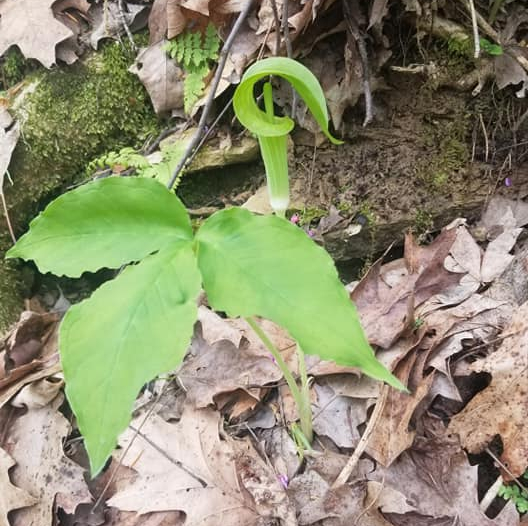
Jack in the Pulpit, Arisaema Triphyllum
Perhaps the most unique wildflower of all our natives, it is a large, cylindrical, hooded flower, green in color with brown to red stripes.
Where to find: You can find this flower on all the trails if you look closely!
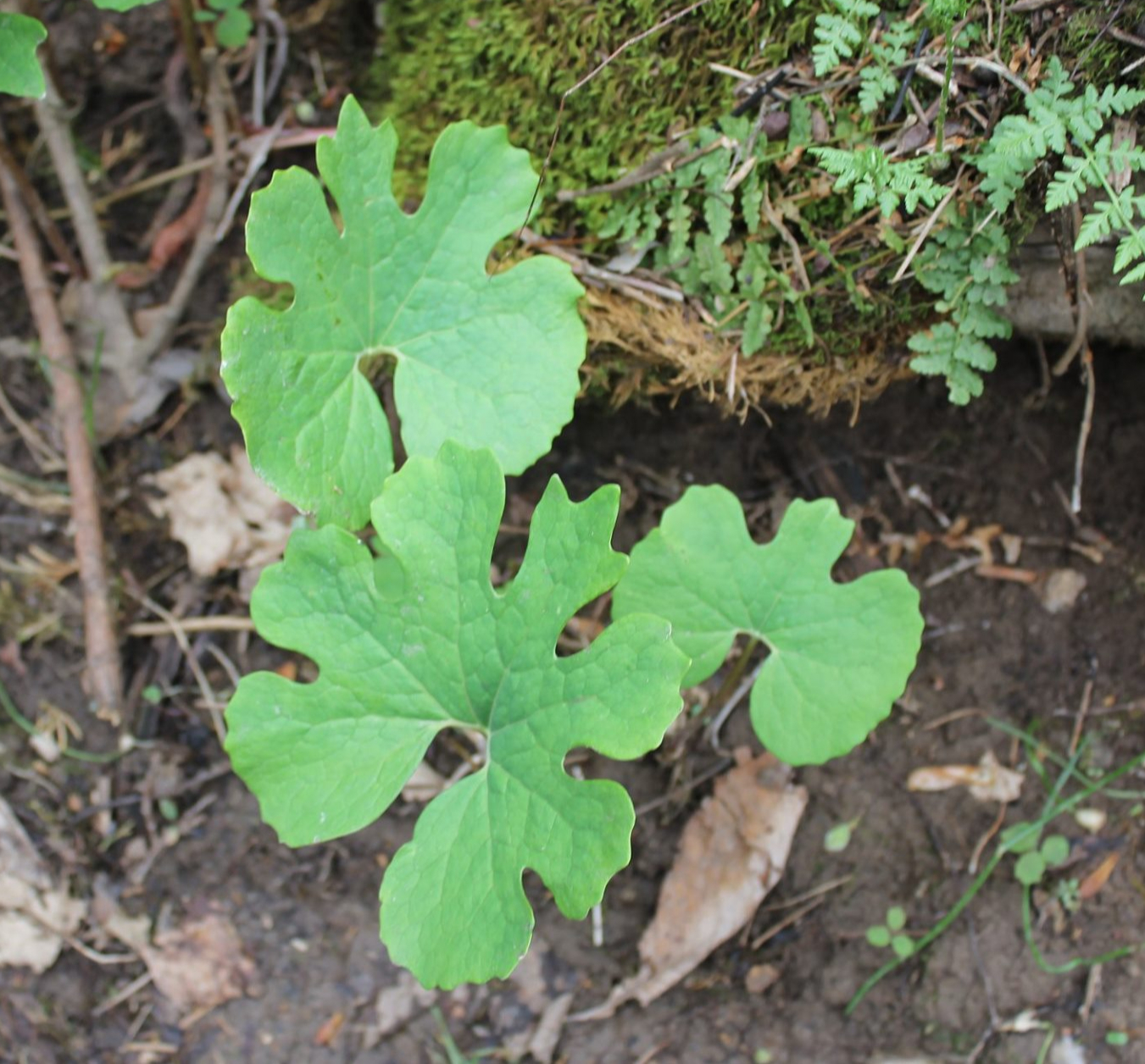
Blood Root, Sanguinaria Canadensis
A very early bloomer, its white flower is seen before its leaf fully opens! Its white flower does not last long, but you can see the leaves for most of the summer along all our trails. The red juice from the underground stem was used by Indians as a dye for baskets, clothing, and face paint, as well as for insect repellent.

May Apple, Podophyllum Peltatum
Easy to find with their large umbrella-like leaves, the may apple is usually found in clusters! In the photo, they have not yet bloomed, but once they do, you'll have to peek under the leaf to find its large white flower. After blooming, it will produce a small “may apple” fruit, which is considered poisonous! This is one forbidden fruit but a great ground cover for viewing in a woodland setting!
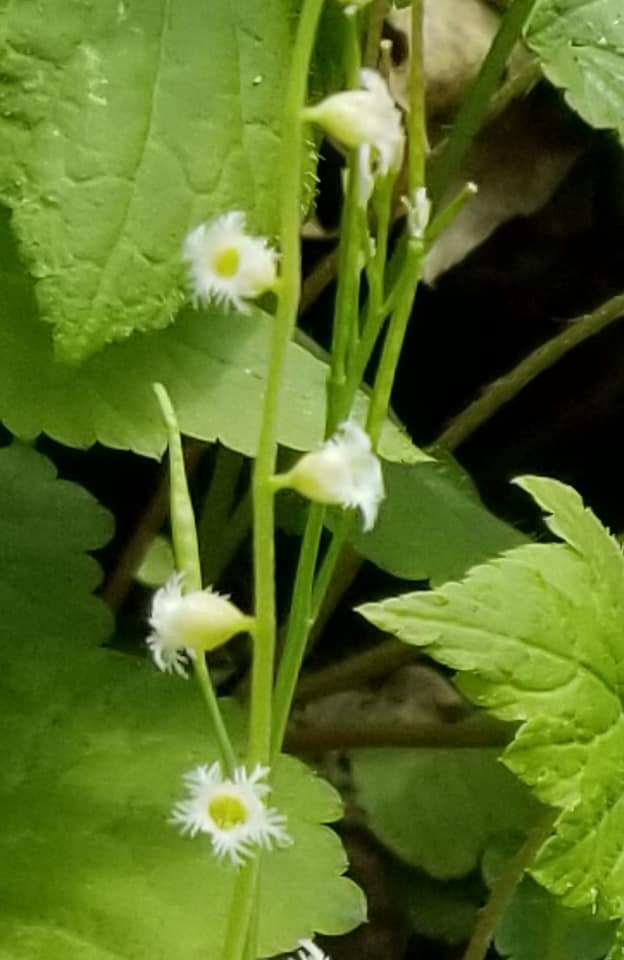
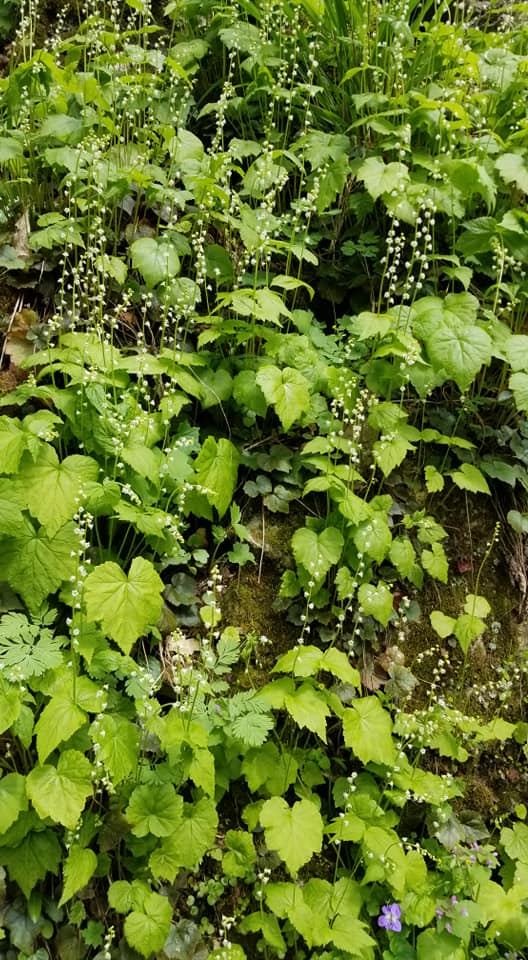
Bishop's Cap, Mitella Diphylla
One of the smallest blooms of any of the native wildflowers, be sure to take a closer look when you see them! The flowers are pollinated by Syrphid flies and small short-tongued bees (including Halictid bees and Little Carpenter bees). These insects suck nectar from the flowers; the Syrphid flies also feed on the pollen, while the short-tongued bees collect pollen for their larvae.
Where to find: The best display is on trail 1 as you walk between the large boulders!
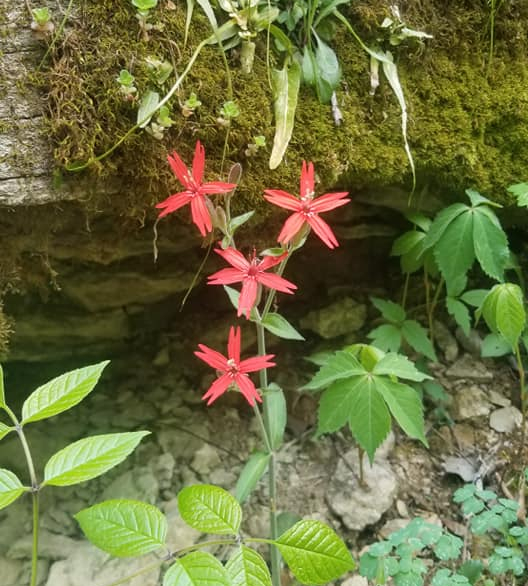
Fire Pink, Silene Virginica
This short-lived wildflower is a rare sight in our forests, but when you find it, you won’t mistake this bright red flower. A common name for members of this genus is Catchfly, which refers to the sticky hairs or 'exudates' which trap insects.

Common Violet, Viola Sororia
This small flower grows like a ground cover and, though many consider it a weed in their lawns, wildlife loves it. The caterpillars of many Fritillary butterflies feed on the foliage. Various upland game birds and small mammals occasionally eat its seeds, including Wild Turkey, Bobwhite, Mourning Dove, and White-Footed Mouse. Wild Turkeys also eat the leaves and fleshy roots. The flowers and young leaves of violets are edible, and can be added to salads in small amounts, or made into a jelly.

Sessile Trillium, Trillium Sessile
Sometimes called "toadshade" imagine a toad or frog hanging out under its 3 large leaves. We love its unique deep red flower that reminds us of a small candle flame!
Where to find: This common wildflower can be found on all the trails, sometimes growing right in the path!

Squirrel Corn, Dicentra Canadensis
A unique wildflower, some may recognize it as a relative to Bleeding Hearts. Also similar to Dutchman's Breeches, another native wildflower. The flower is tighter and more heart-shaped than Dutchman's breeches and usually begins blooming about a week later.

Dutchman's Breeches, Dicentra Cucullaria
As you may see, it is very similar to the "Squirrel Corn" flower. Dutchman's Breeches flowers are more "V" shaped, resembling a pair of pants, or 'breeches', hanging on a line. Pollinated by both Bumblebees and Honeybees. This wildflower peaks early and will go dormant as temperatures climb.
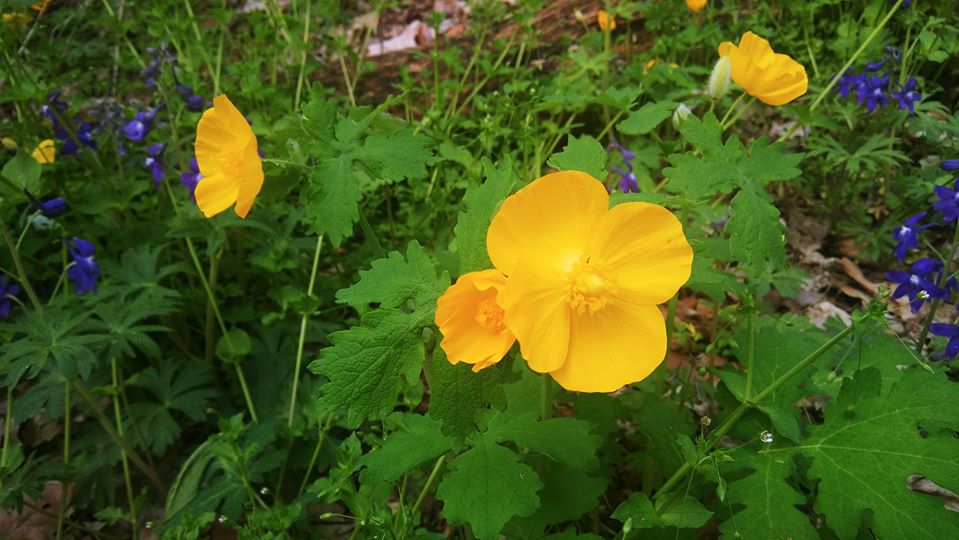
Celandine Poppy, Stylophorum Diphyllum
This wildflower is sometimes called Yellow Wood Poppy. Its stems produce a bright yellow sap that Native Americans used as a dye. Keep an eye out for its fuzzy seed pods!

Purple Phacelia, Phacelia Bipinnatifida
A common but somewhat unknown wildflower, Phacelia loves rocky forest habitats, thus can be found on all the trails. Growing 2 feet tall and self-seeding, you will often see large stands of this lovely wildflower blanketing the forest floor. Native bees love this plant and we do too!
Where to find: All trails have examples of this flower.
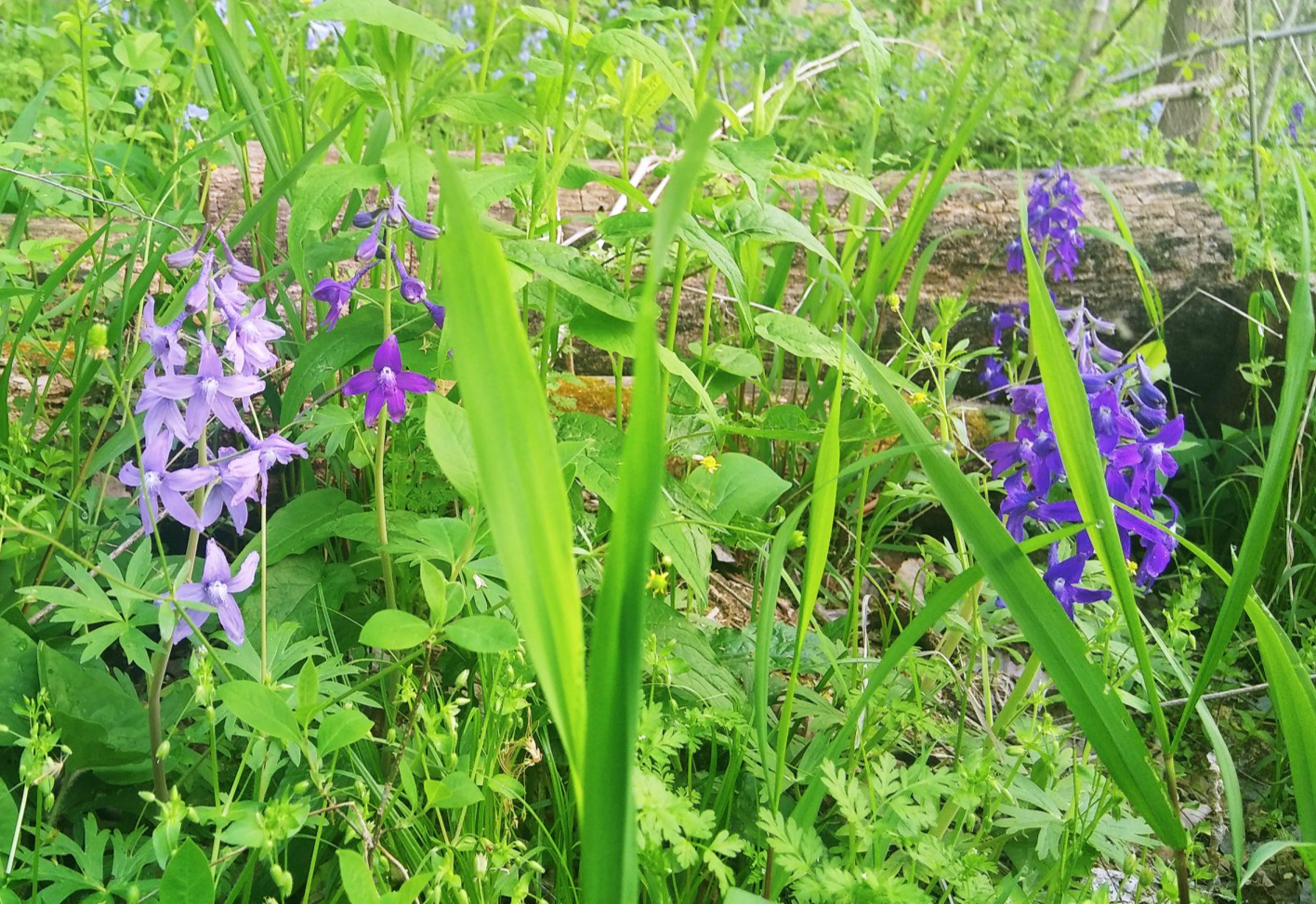
Dwarf Larkspur, Delphinium Tricorne
As with all Delphiniums, you can identify them by the spur on the backside of the bloom. As seen in the photos, flower ranges from deep purple to almost solid white. These and other delphiniums are toxic and can be fatal if eaten!
Where to find: These are in large stands on all our trails, but the bottom of trail 6 has impressive displays of them mixed with the Bluebells and Yellow poppies!
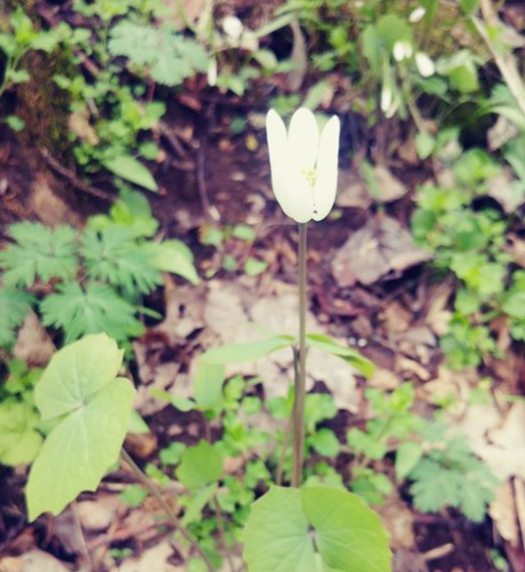
TwinLeaf, Jeffersonia Diphylla
Named after Thomas Jefferson, the Twinleaf only blooms for one day! But its leaves, which appear to be mirror images of each other will stick around for more than a month.
Where to find: Large clusters of these can be seen in greatest abundance along Trail 5.

The Spring Beauty, Claytonia Virginica
Found throughout the Eastern United States, these small white and pink wildflowers are one of the first to blanket the forest floor in spring. The pink stripes on each petal are said to attract insects to the pollen in the center of each flower! These can even be found in your own yard if you have not mowed yet this season!
Photos and wildflower descriptions were provided by Charlestown State Park staff or Friends of Charlestown State Park volunteers.





